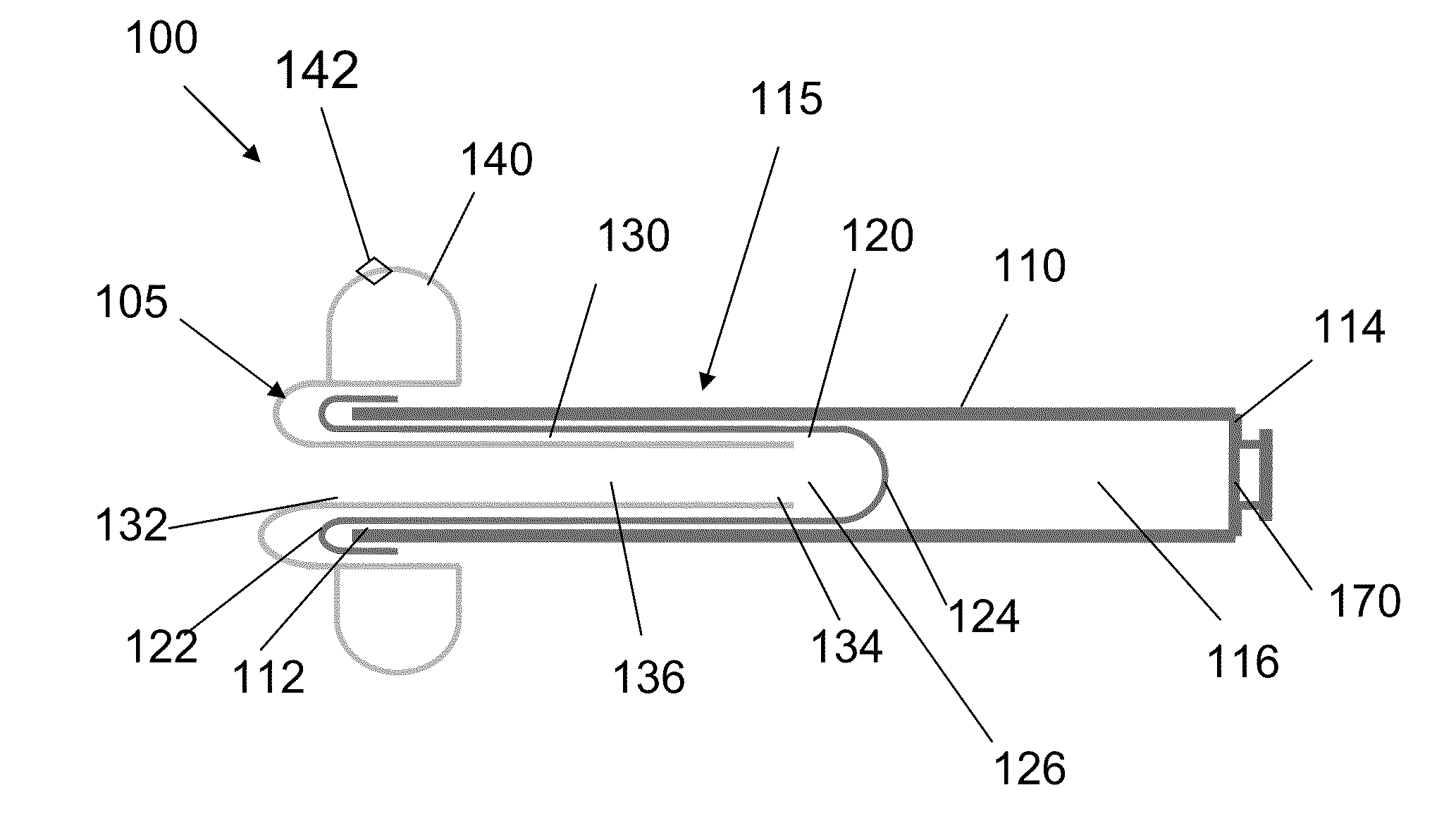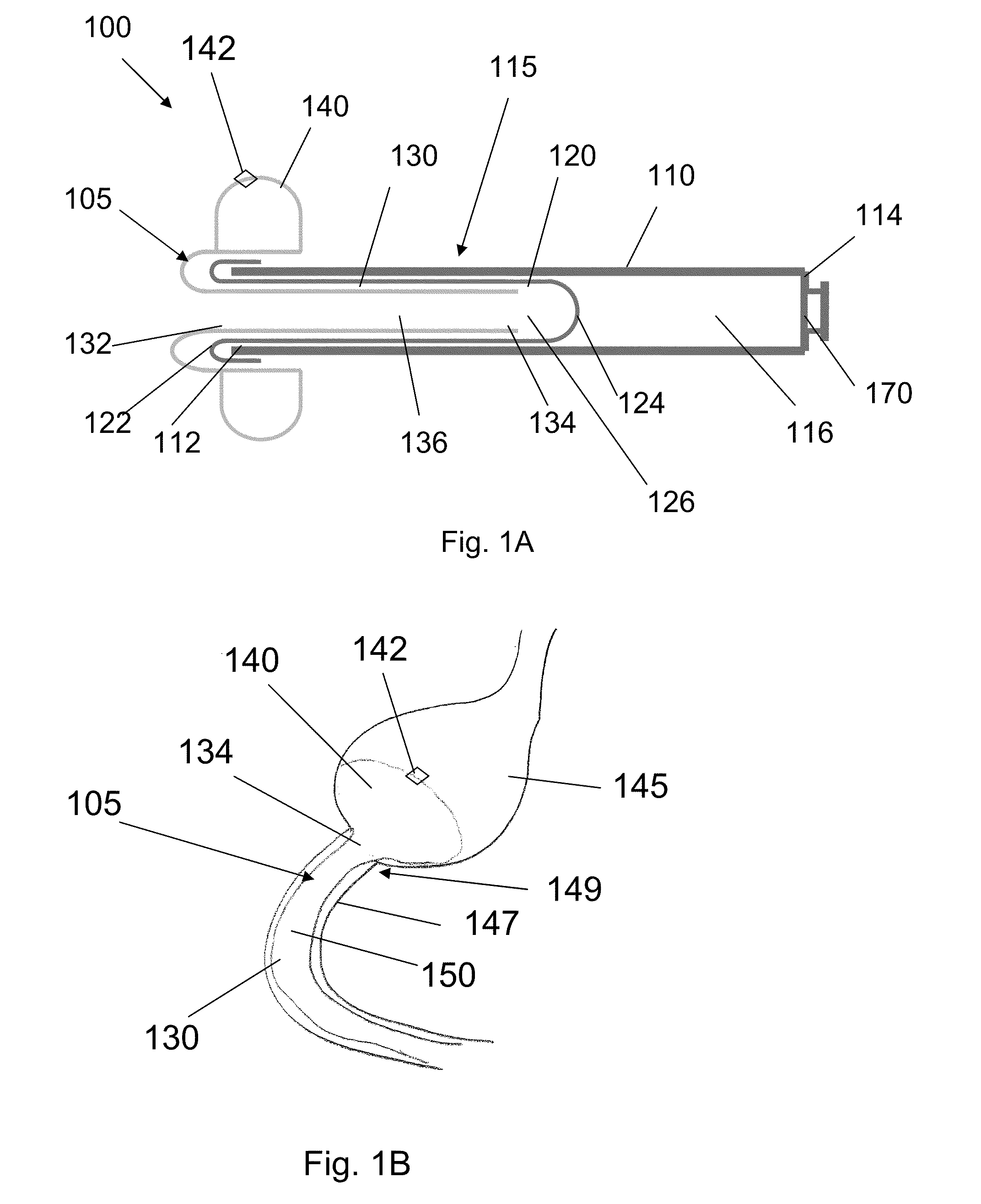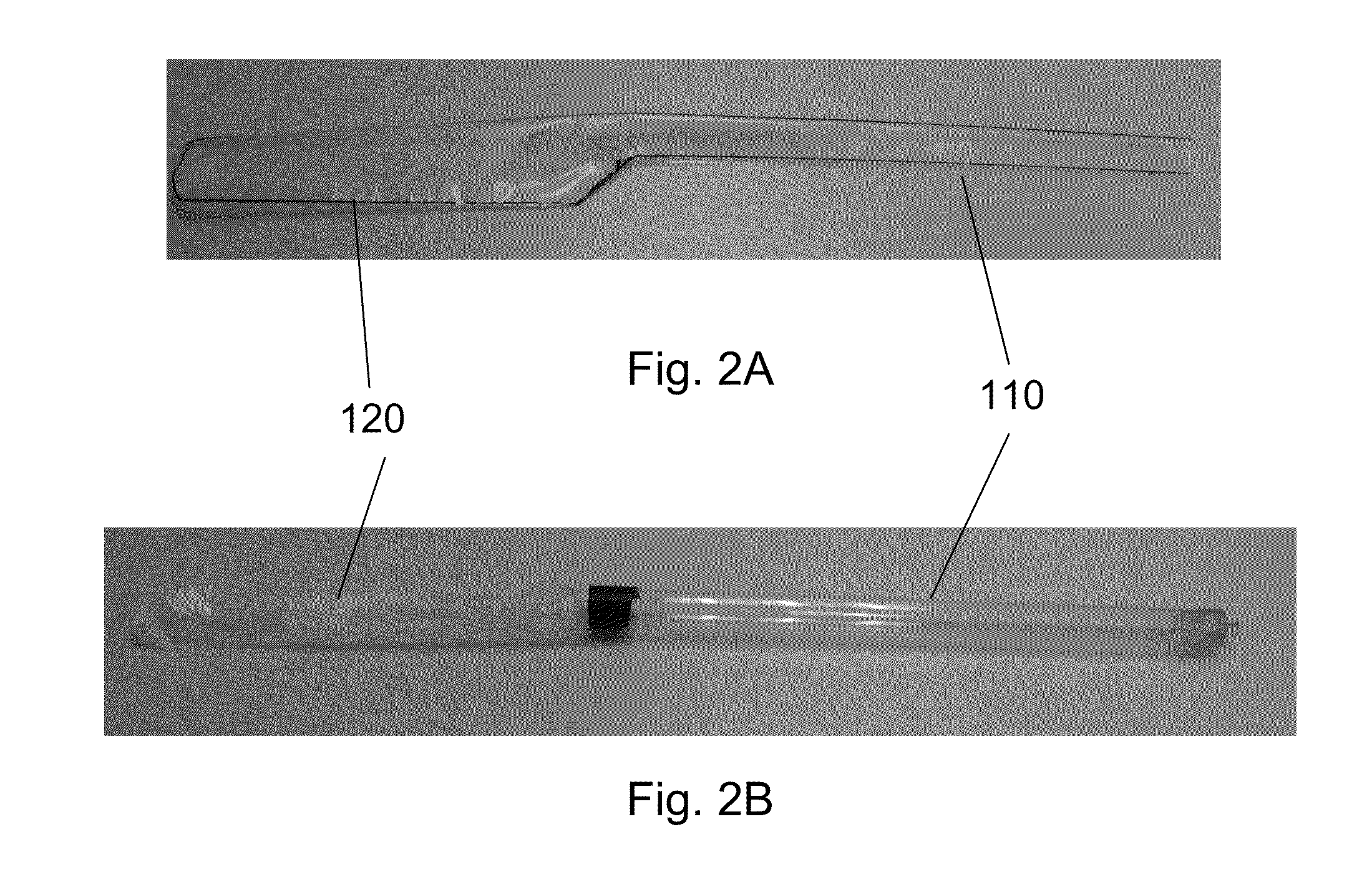[0020]The present invention provides, in an embodiment, a
gastrointestinal implant device. The
gastrointestinal implant device can include a sleeve for placement into a
small intestine and to minimize absorption of nutrients by a wall of the small intestine. The sleeve, in an embodiment, may be made from a sufficiently flexible material to permit the sleeve to move between an inverted position and an everted position. In certain embodiments, the sleeve may be made from a material having substantially
low permeability, so as to minimize absorption of nutrients from the
digested food by the wall of the small intestine. The gastrointestinal
implant device, in an embodiment, can also include an anchoring mechanism coupled to a proximal end of the sleeve and designed to be secured within a stomach, so as to allow the sleeve to securely extend into the small intestine. In some embodiments, the anchoring mechanism is designed to reduce functional volume of the stomach. The anchoring mechanism, in one example, can be an
inflatable balloon sufficiently large to prevent the
inflatable balloon from entry into the small intestine. To that end, the anchoring mechanism may include a port for inflating the anchoring mechanism. The anchoring mechanism may alternatively be a self-expanding frame which, upon expansion, can be substantially frustoconical in shape for securing against a wall of the stomach, while allowing the stomach to maintain a substantially full functional volume. The gastrointestinal
implant device, in an embodiment, can further include a passageway extending through the anchoring mechanism and the sleeve, and along which
digested food can be directed from the stomach into the small intestine.
[0021]The present invention further provides, in another embodiment, a bariatric therapy
system. The
system can include a gastrointestinal
implant device. The device, in an embodiment, can include a sleeve for placement into a small intestine and to minimize absorption of nutrients by a wall of the small intestine. The device can also include an anchoring mechanism coupled to a proximal end of the sleeve and designed to be secured within a stomach so as to allow the sleeve to securely extend into the small intestine. In some embodiments, the anchoring mechanism can be an
inflatable balloon designed to reduce functional volume of the stomach upon inflation and may be designed to include a port for inflating the anchoring mechanism. The anchoring mechanism, in certain embodiments, can also be a self-expanding frame which, upon expansion, can be substantially frustoconical in shape for securing against a wall of the stomach while allowing the stomach to maintain a substantially full functional volume. The device can further include a passageway extending through the anchoring mechanism and the sleeve, and along which
digested food can be directed from the stomach to the small intestine. In addition to the device, the system can further include a delivery mechanism for directing the device to
a site of implantation. The delivery mechanism, in an embodiment, can include a housing for accommodating the device. The housing can be provided with a delivery end, an opposing proximal end, and a passageway therebetween. In certain embodiments, the housing can be substantially tubular in shape and / or made from a sufficiently flexible material for accommodating the device. The delivery mechanism, in an embodiment, can also include a deploying balloon, situated within the passageway of the housing, for accommodating the sleeve of the device. The balloon may be provided with an open end attached to the delivery end of the housing and a closed end situated within the housing, such that in the presence of
positive pressure within the passageway of the housing, the balloon can be everted from within the housing to direct the sleeve of the device into the small intestine. A port, in an example, can be provided on the housing through which
positive pressure can be introduced into the housing. The port, in an embodiment, can be provided with an inflation device detachably connected thereto. In addition, a gastroscope for guiding the system to the site of implantation can also be provided for use in connection with the system of the present invention.
[0023]The present invention additionally provides, in another embodiment, a method for providing bariatric therapy. The method can include everting a sleeve from an inverted position into a small intestine. In an embodiment,
positive pressure can be used to cause eversion of the sleeve. The method can further include anchoring the sleeve at its proximal end adjacent a pyloric junction between stomach and mall intestine. The anchoring step, in an embodiment, can include securing an anchoring mechanism coupled to a proximal end of the sleeve within the stomach so as to allow the sleeve to securely extend into the small intestine. The method, in some embodiments, can further include allowing digested food to be directed from the stomach through the anchoring mechanism into the sleeve, while minimizing absorption of nutrients from the digested food by a wall of the small intestine. In addition, to the extend desired, the method can further include guiding the sleeve to
a site of implantation with a gastroscope.
[0024]The present invention further provides, in an embodiment, another gastrointestinal implant device. The device includes a plurality of struts that are interconnected to define an expandable body. In some embodiments, the expandable body is sufficiently elastic and capable of contracting and expanding along with stomach
peristalsis without being expelled therefrom. The expandable body may also be designed to exert a pressure against a wall of the stomach to distend the stomach and provide a feeling of satiety upon expansion. In addition, the expandable body may include an expandable mechanism which, upon expansion, reduces a functional volume of the stomach. The device additionally includes a plurality of openings situated between the struts, the openings designed to allow food to enter into the expandable body through a first opening and to exit from the expandable body through a second opening. The device further includes a sleeve having an entrance that is coupled to the expandable body, such that the entrance is in alignment with the second opening to direct the food into the sleeve. In certain embodiments, the sleeve is designed for placement into a small intestine and to minimize absorption of nutrients by a wall of the small intestine.
[0025]The present invention also provides, in a further embodiment, yet another gastrointestinal implant device. The device includes a first anchoring mechanism designed to be secured along a
gastrointestinal tract and within a stomach. The first anchoring mechanism, in an embodiment, is expandable to reduce a functional volume of the stomach. The device further includes a second anchoring mechanism coupled to and spaced from the first anchoring mechanism, the second anchoring mechanism being designed to be secured further along the
gastrointestinal tract and beyond the stomach. In an embodiment, the second anchoring mechanism is designed to be secured within a
duodenum by exerting a radial force against a wall of the
duodenum. The second anchoring mechanism may be coupled to the first anchoring mechanism via a
tethering mechanism. For example, the
tethering mechanism may be a proximal portion of the sleeve, or one or more tethers. The
tethering mechanism, in an embodiment, may be sufficiently elastic to allow the first and / or second anchoring mechanism to exert a compressive force on a
pylorus, so as to maximize anchoring of the first and second anchoring mechanisms adjacent the
pylorus. The device additionally includes a sleeve coupled to and positioned outside the second anchoring mechanism, the sleeve being designed for placement into a small intestine and to minimize absorption of nutrients by a wall of the small intestine. In an embodiment, the sleeve is circumferentially situated about an outer surface of the second anchoring mechanism. In some embodiments, the second anchoring mechanism may be designed to expand to contact the wall of the
duodenum, so as to seal the sleeve against the wall of the duodenum.
 Login to View More
Login to View More  Login to View More
Login to View More 


